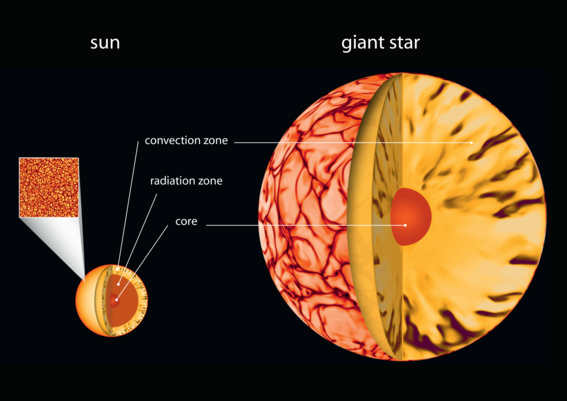Turbulent convection at the heart of stellar activity

Different stars can exhibit very different levels of activity. The Sun’s coronal mass ejections, flares and sunspots – all signs of solar activity – are rather feeble on an astronomical scale. Other stars are up to ten times more active, for example sporting huge starspots that cover a large portion of their disc. While researchers have long identified the magnetic fields generated in the interior of stars in a dynamo process as drivers of activity, the exact workings of this dynamo are still unclear. A collaboration between researchers at Max Planck Institute for Solar System Research (MPS) in Germany and Aalto university searched for an answer by applying the same analysis to a sample of both main sequence and more evolved stars. They find that a common, turbulence-dependent dynamo mechanism plays a crucial role for stellar activity in all stages of stellar evolution. The results are published in next week’s issue of Nature Astronomy.
The inside Stars are structured in a layered, onion-like fashion. Stars with temperatures like our sun have cores surrounded by a radiation zone. In this zone, the heat from the core is led outwards by radiation. As the stellar plasma becomes cooler farther away the core, heat moves by plasma flows: hot plasma from within rises to the surface, cools, and sinks down again. This process is called convection. At the same time, the star’s rotation, which depends on stellar latitude, introduces sideways movements. Together, both processes twist and twirl magnetic forces to create a star’s complex magnetic field, in a dynamo process that is not yet fully understood.
“Unfortunately, we cannot look directly into the Sun and other stars to see these processes in action, but have to resort to more indirect methods”, says Dr. Jyri Lehtinen from MPS, first author of the new publication. In their current study, the researchers compared different stars’ activity levels on the one hand, and their rotational and convective properties on the other. The goal was to determine which properties have a strong influence on activity. This can help to understand the specifics of the dynamo process within.
Several models of the stellar dynamo have been proposed in the past, but two main ideas prevail. While one of them puts a greater emphasis on the rotation and assumes only subtle effects of convectional flows, the other depends crucially on turbulent convection. In this type of convection, the hot stellar plasma does not rise to the surface in large-scale, sedate motions, but rather that small-scale vigorous flows dominate.
In order to find evidence for one or the other of the two paradigms, Lehtinen and his colleagues for the first time took a look at 224 very different stars. Their sample contained both main-sequence stars, which are in the prime of their life, and older, more evolved giant stars. Typically, both convection and rotational properties of stars change as they age. Compared to main sequence stars, evolved stars exhibit a thicker convection zone often expanding over much of the star’s diameter and sometimes superseding the radiation zone completely. This leads to longer turnover times for convective heat transport. At the same time, rotation usually slows down.
For their study, the researchers analyzed a data set obtained at Mount Wilson Observatory in California (USA), which over several years recorded the stars’ emissions in wavelengths typical of calcium ions found in the stellar plasma. These emissions are not only correlated with the stars’ activity level. Complex data processing also made it possible to infer the stars’ rotation periods.
Like the Sun, stars are sometimes dappled with regions of extremely high magnetic field strength, so-called active regions, which are often associated with dark spots on the stars’ visible surface. “As a star rotates, these regions come into view and pass out of it leading to a periodic rise and fall in emission brightness”, Prof. Dr. Maarit Käpylä from Aalto University in Finland –and who also heads the research group Solar and Stellar Dynamos at MPS– explains. However, since stellar emissions can also fluctuate due to other effects, identifying periodic variations – especially over long periods – is tricky.
"Some of the stars we studied show rotation periods of several hundreds of days, and surprisingly still a magnetic activity level similar to the other stars, and remarkably even magnetic cycles like the Sun", says Dr. Nigul Olspert from MPS, who analyzed the data. The Sun, in comparison, rotates rather briskly with a rotation period of only approximately 25 days at the solar equator. The convective turnover times were calculated by means of stellar structure modelling taking into account each star’s mass, chemical composition, and evolutionary stage.
The scientists’ analysis shows that a star’s activity level does not depend only on its rotation, as had been suggested by other studies based on smaller and more uniform samples including only main sequence stars. Instead, only if convection is accounted for, can the behavior of main-sequence and evolved stars be understood in a unified manner. “The co‑action of rotation and convection determine how active a star is”, Prof. Käpylä summarizes. “Our results tip the scales in favor of the dynamo mechanism including turbulent convection”, she adds.
More Information:
Jyri J. Lehtinen, Federico Spada, Maarit J. Käpylä, Nigul Olspert, Petri J. Käpylä:
Common dynamo scaling in slowly rotating young and evolved stars,
Nature Astronomy, 9 March, 2020
https://doi.org/10.1038/s41550-020-1039-x
Contact the Researchers:

Read more news

DeployAI Partners Gather for Heart Beat Meeting in Helsinki
The European DeployAI project's partners gathered for the Heart Beat meeting hosted by Aalto University Executive Education in Helsinki.
Aalto computer scientists in ICML 2024
Computer scientists in ICML 2024
In low-hierarchy organisations, even key policy issues are discussed in Slack
In a recent study, Aalto University alumn Lauri Pietinalho, a visiting scholar at New York University's Stern School of Business, and Frank Martela, an assistant professor at Aalto University, investigated how low-hierarchy organisations deal with shared policies in confrontational situations and how authority functions within them.